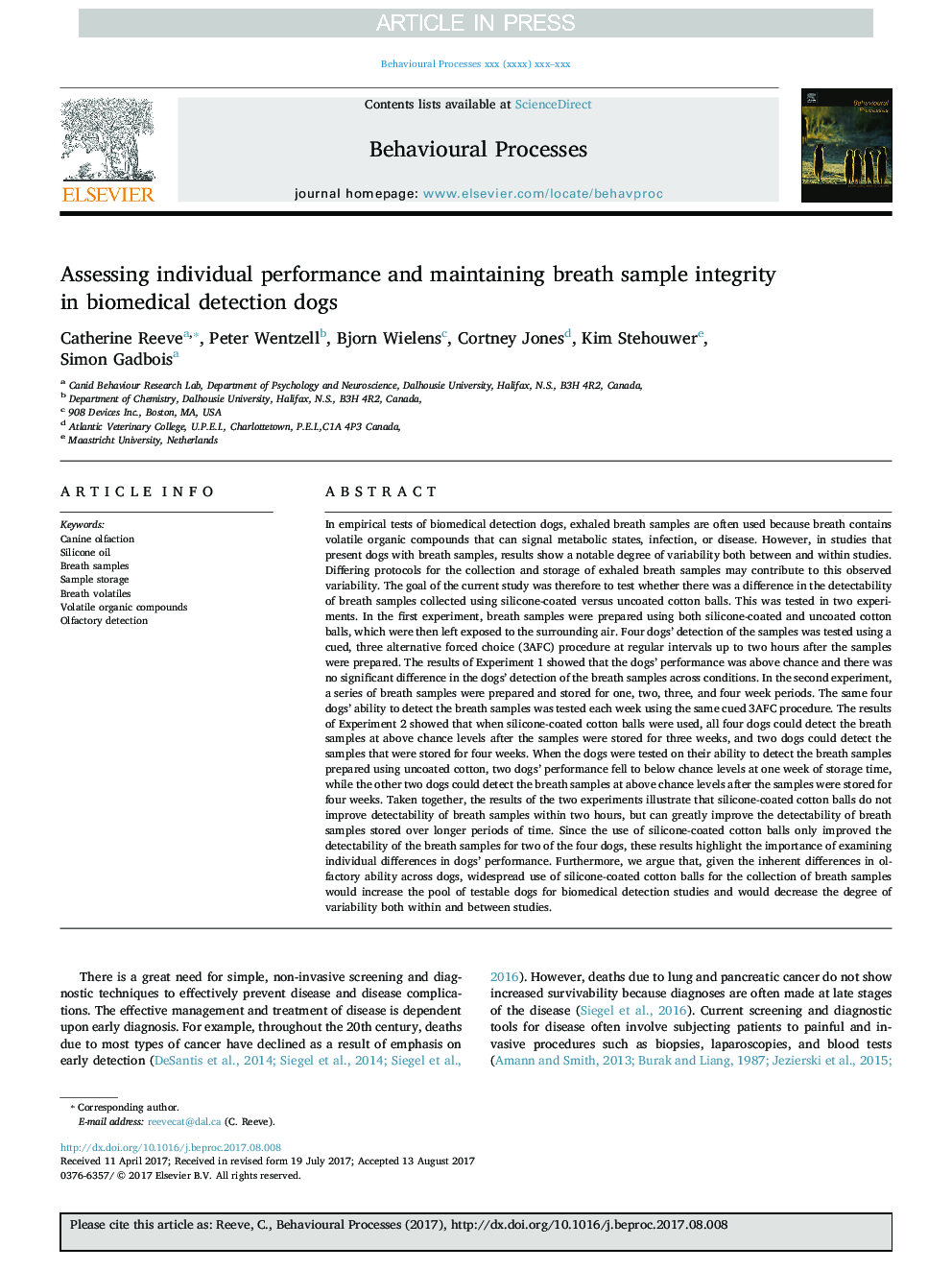| کد مقاله | کد نشریه | سال انتشار | مقاله انگلیسی | نسخه تمام متن |
|---|---|---|---|---|
| 10158024 | 1666503 | 2018 | 11 صفحه PDF | دانلود رایگان |
عنوان انگلیسی مقاله ISI
Assessing individual performance and maintaining breath sample integrity in biomedical detection dogs
ترجمه فارسی عنوان
ارزیابی عملکرد فردی و حفظ یکپارچگی نمونه گیری تنفس در سگ های تشخیص زیست پزشکی
دانلود مقاله + سفارش ترجمه
دانلود مقاله ISI انگلیسی
رایگان برای ایرانیان
کلمات کلیدی
التهاب سگ، روغن سیلیکون، نمونه های نفس، ذخیره سازی نمونه، فرار از نفس، ترکیبات آلی فرار، تشخیص عفونت،
موضوعات مرتبط
علوم زیستی و بیوفناوری
علوم کشاورزی و بیولوژیک
علوم دامی و جانورشناسی
چکیده انگلیسی
In empirical tests of biomedical detection dogs, exhaled breath samples are often used because breath contains volatile organic compounds that can signal metabolic states, infection, or disease. However, in studies that present dogs with breath samples, results show a notable degree of variability both between and within studies. Differing protocols for the collection and storage of exhaled breath samples may contribute to this observed variability. The goal of the current study was therefore to test whether there was a difference in the detectability of breath samples collected using silicone-coated versus uncoated cotton balls. This was tested in two experiments. In the first experiment, breath samples were prepared using both silicone-coated and uncoated cotton balls, which were then left exposed to the surrounding air. Four dogs' detection of the samples was tested using a cued, three alternative forced choice (3AFC) procedure at regular intervals up to two hours after the samples were prepared. The results of Experiment 1 showed that the dogs' performance was above chance and there was no significant difference in the dogs' detection of the breath samples across conditions. In the second experiment, a series of breath samples were prepared and stored for one, two, three, and four week periods. The same four dogs' ability to detect the breath samples was tested each week using the same cued 3AFC procedure. The results of Experiment 2 showed that when silicone-coated cotton balls were used, all four dogs could detect the breath samples at above chance levels after the samples were stored for three weeks, and two dogs could detect the samples that were stored for four weeks. When the dogs were tested on their ability to detect the breath samples prepared using uncoated cotton, two dogs' performance fell to below chance levels at one week of storage time, while the other two dogs could detect the breath samples at above chance levels after the samples were stored for four weeks. Taken together, the results of the two experiments illustrate that silicone-coated cotton balls do not improve detectability of breath samples within two hours, but can greatly improve the detectability of breath samples stored over longer periods of time. Since the use of silicone-coated cotton balls only improved the detectability of the breath samples for two of the four dogs, these results highlight the importance of examining individual differences in dogs' performance. Furthermore, we argue that, given the inherent differences in olfactory ability across dogs, widespread use of silicone-coated cotton balls for the collection of breath samples would increase the pool of testable dogs for biomedical detection studies and would decrease the degree of variability both within and between studies.
ناشر
Database: Elsevier - ScienceDirect (ساینس دایرکت)
Journal: Behavioural Processes - Volume 155, October 2018, Pages 8-18
Journal: Behavioural Processes - Volume 155, October 2018, Pages 8-18
نویسندگان
Catherine Reeve, Peter Wentzell, Bjorn Wielens, Cortney Jones, Kim Stehouwer, Simon Gadbois,
